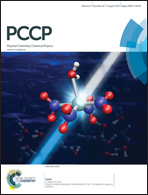Quantum interference and structure-dependent orbital-filling effects on the thermoelectric properties of quantum dot molecules†
Abstract
The quantum interference and orbital filling effects on the thermoelectric (TE) properties of quantum dot (QD) molecules with high figure of merit are illustrated via the full solution to the Hubbard–Anderson model in the Coulomb blockade regime. It is found that under certain conditions in the triangular QD molecule (TQDM), destructive quantum interference (QI) can occur, which leads to vanishingly small electrical conductance, while the Seebeck coefficient is modified dramatically. When the TQDM is in the charge localization state due to QI, the Seebeck coefficient is seriously suppressed at low temperature, but is highly enhanced at high temperature. Meanwhile, the behavior of the Lorenz number reveals that it is easier to block charge transport via destructive QI than the electron heat transport at high temperatures. The maximum power factor (PF) in the TQDM occurs under full-filling conditions. Nevertheless, low-filling conditions are preferred for getting the maximum PF in serially coupled triple QDs in general. In double QDs, the maximum PF can be achieved either with orbital-depletion or orbital-filling as a result of electron–hole symmetry. Our theoretical work provides a useful guideline for the advancement of the nanoscale TE technology.


 Please wait while we load your content...
Please wait while we load your content...